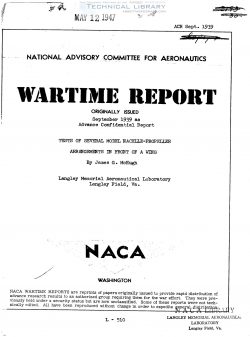naca-wr-l-510
- Version
- 116 Downloads
- 1.41 MB File Size
- 1 File Count
- April 2, 2017 Create Date
- April 2, 2017 Last Updated
Tests of Several Model Nacelle Propeller Arrangements in Front of a Wing

_ By James G. lcfiugh
SUIHARY
in investigation was conducted in the N.L.O.i. 20—
fodt wind tunnel to determine the drag, the propulsive and
net_efficiencies, and the cooling oharahteristios of sev-
eral scale-model arrangements of air-cooled radial-engine
nacelles and present-day propellers in front of an 18-
peroent-thick. 5- by 15-foot airfoil. Investigations of
like arrangements simulating the geometric proportions of
airplanes in the 20,000—pound weight classification have
been conducted by the N.A.C.A. and the results are summa-
rized in previous reports. This report deals with an in-
vestigation of wingnnacelle arrangements simulating the
geometric proportions of airplanes in the 40.000- to 70.000~
pound weight classification and having the nacelles located
in the vicinity of the optimum location determined from the
earlier tests.
Two 3-b1ade propellers with diameters of 36 and 48
inches, respectively, were each tested in conjunction with
a lE—inch-diamoter nacelle in three positions in front of
the wing and with a 16-ineh-diameter nacelle in six posi-
tions in front of the wing. Lift. drag. cooling-air flow.
and propeller characteristics were determined for each of
the arrangements. Comparisons on the basis of net effi-
ciency between the various arrangements indicated that.
for'high-speed and cruising conditions. the most-favorable
location for a tractor naoelle-propeller arrangement of
the type tested was with the thrust axis on the wing cen-
ter line and with the propeller between 15 and 30 percent
of the chord forward of the leading edge of the wing. The
loss in net efficiency through the use of either large-
diameter engines or nacelle installations having a high
interference drag is clearly indicated. '
In certain cases, the.action of the propeller slip-
stream on the flow pattern over the wing-nacelle arrange-
ment may he such as greatly to influence the cooling qual-
ities of a given wing—nacelle—propeller arrangement.
Irrnonuorxom
The design of engine-nacelle installations for large
airplanes has always involved a certain amount of conjec-
ture en the part of airplane designers. Several years ago
the K.L.O.A. conducted a lengthy investigation for the
purpose of establishing an optimum arrangement of the wing-
nacelle-propeller combination (reference 1). That inves-
tigation covered a large range of variatidns in nacelle
position and yielded results that have been of considerable
value to designers. The tests of reference 1 were made
with a nacelle of relatively large diameter as compared
with the wing thickness, were conducted through a'propeller
operating range that would be used only in the take-off and
climbing range of present-day airplanes, and did not in-
clude either a thorough investigation of the effects on net
efficiency of small changes'in-nacelle location from the
optimum location found nor measurements of cooling-air flow
through the cowling.
In order to make a more detailed study of nacelle lo—
cations in the vicinity of the best position found in the
previous test program and to investigate arrangements suit-
able for the 40.000- to 70,000-pound airplane classifica-
tion, the N.A.G.A. has instituted an investigation in the
20-foot wind tunnel of wing-nacelle-propeller interference
in which a wing. propellers. and engine-nacelle models
simulating modern practice were used. The phases of the
investigation that have been completed to date include (a)
measurements of drag, propeller, and cooling characteristics
for several combinations of geometrically similar propel-
lers and nacelres of different nacelle-propeller diameter
ratios with no wing present and (b) measurements of lift.
drag. propeller. and'coeling characteristics for the same
nacelle-propeller ccmbinations in several positions in
front of a thick wing. Part (a) has been reported in ref-
erence 2: this report presents the results of part (b).
| File | Action |
|---|---|
| naca-wr-l-510 Tests of Several Model Nacelle Propeller Arrangements in Front of a Wing.pdf | Download |

Comment On This Post